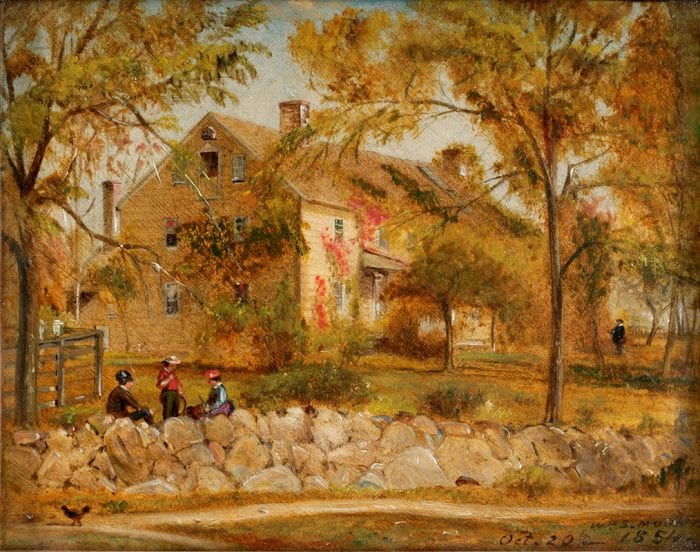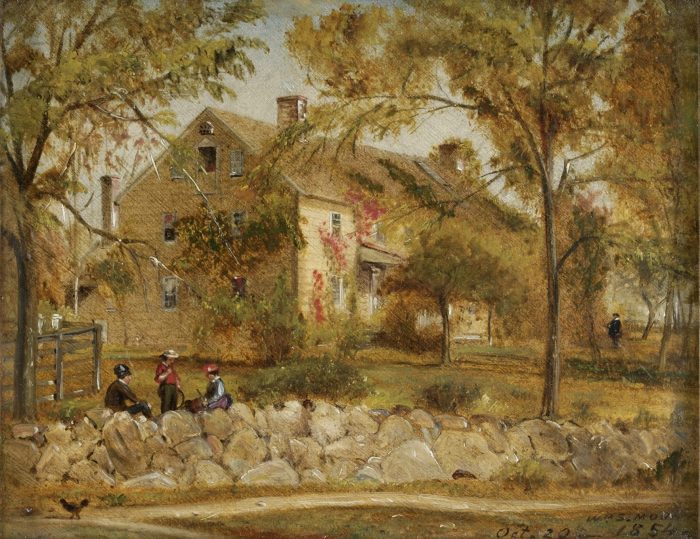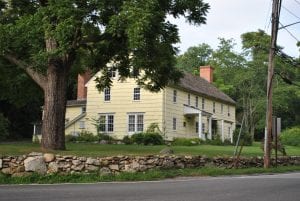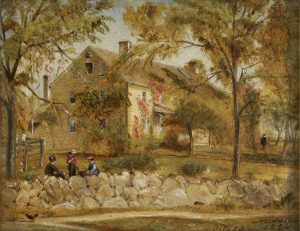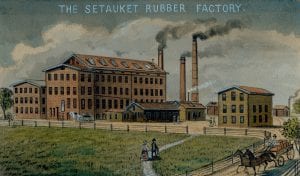By Corey Geske
“When Gen. George Washington was passing through Stony Brook . . . Mother was at that time a little school girl, and stood and courtesyed [curtsied] to him while he raised his hat to her salutation — at the same time, her companions ran away.”
— William Sidney Mount, 1859
American genre painter William Sidney Mount and English born watercolorist Alexander George Milne preserved the earliest known visual and recorded perspectives near their homes of what is today known as the Culper Spy Trail, the route followed in April 1790 by America’s first president George Washington on what was ostensibly a ‘victory tour’ of Long Island. Today, circumstantial evidence begs two questions: did Mount know the victory tour was a ‘cover story’ for thanking Long Island spies who helped win the American Revolution; and did Mount know his grandfather Jonas Hawkins was a spy?
When General Washington acknowledged the salutation of Julia Ann Hawkins (1782-1841), Mount’s future mother, on an April day in Stony Brook, he was, in effect and likely without knowing it, thanking the daughter of one of his spies. About eight years old at the time, Julia exhibited courageous respect while her “companions ran away.” She personified the courage of her father, Major Jonas Hawkins (1752-1817). Although not yet achieving military rank, Hawkins risked his life from December 1778 through mid-August 1779 as a courier in Washington’s Culper Spy Ring, which gathered and relayed intelligence from British occupied Long Island to the General’s headquarters during the war.
In 1854, when William Sidney Mount (1807-1868) painted his ancestral family home, The Mount House, he chose the location where Julia may have seen Washington and the artist recorded the perspective Washington could have had from his carriage when he doffed his hat to Julia as she curtsied. Mount’s view includes a young girl seated on the roadside wall, a seeming leader of two boys who, in a visual counterpoint to his mother’s runaway companions, direct their attention toward her, while a gentleman wearing a Peter Stuyvesant-type coat surveys the scene from afar, as a distant reminder of the Hawkins family that helped found (1655) the Town of Brookhaven.
A few miles to the south in Smithtown, Alexander George Milne (1801-1865), an émigré from England c. 1834-1836, recorded, on at least four occasions, the route west in the direction Washington traveled, careful to focus on the architectural lines of the Widow Blydenburgh’s Tavern where Washington stopped about an hour after passing the Hawkins’ home. Milne’s expansive view of Smithtown, Long Island was completed in watercolors, c. 1857, three years after The Mount House. The Widow Blydenburgh’s Tavern is seen to the far right. In front of it, Milne detailed a sapling tree. Fenced for protection from roving farmstock, it was one of the nearly sixty ship-mast locust trees planted by Judge J. Lawrence Smith and Joseph Howell along Smithtown’s main thoroughfare, from April 17 to 22, 1855 and 1856, coincidentally, the April anniversaries of Washington’s tour, for the two years following Mount’s 1854 painting.
Milne’s inclusion of a sleigh with two horses halted before the Blydenburgh Tavern was a reminder of the four grey horses drawing Washington’s coach painted with his coat of arms and allegorical scenes of the four seasons by Florentine artist Giovanni Battista Cipriani. The President recorded the day in his diary: “Friday 23d. About 8 Oclock we left Roes [Tavern, East Setauket], and baited the Horses at Smiths Town, at a Widow Blidenbergs [Blydenburgh]–a decent House 10 Miles from Setalkat [Setauket]–thence 15 Miles to Huntington where we dined . . .”
Mother’s courage, grandfather’s daring as Culper Spy, breathe life into Mount’s painting
Mount’s memory of his mother’s story was prefaced, “Good introduction to my sketch –,” which suggests this was an idea for what appears to have been a painting of Washington that was never done. Mount did, however, represent Washington in a finished work that offers a psychological clue to a conjectural Mount family view linking Washington’s 1790 visit to the espionage ring his grandfather Jonas Hawkins supported.

Image courtesy of the Metropolitan Museum of Art.
Mount’s 1852 portrait of Great-Grand-Father’s Tale of the Revolution includes a Jean-Antoine Houdon-inspired bust of the General indicated by the extended hand of the 94-year-old friend of Washington, the Rev. Zachariah Greene (1760-1858) of the Setauket Presbyterian Church.
Mount portrays Greene seated at a table reminiscing to his three great-grandchildren in a pose similar to that of Washington, c. 1789-1796, in The Washington Family (National Gallery of Art, Washington, D.C.) by Edward Savage whose work was popularized and even reversed by later artists in an oval format that echoed Mount’s portrait of Greene. The last sitting for the President’s portrait by Savage was April 6, 1790, just before Washington’s tour, with perhaps the very same hat tipped to Julia Hawkins, placed at Washington’s extended hand upon the table where a plan for the new capital city of Washington was studied by the family. Mount translated the General’s hat as Greene’s upturned hat on a nearby chair.
In his younger days, Greene had helped pull down the statue of King George III in Bowling Green after a reading of the Declaration of Independence in July 1776; then served as a corporal for Massachusetts and Connecticut in the American Revolution, being twice wounded at the battle of White Marsh, near Philadelphia, and at White Plains. He’d later become ‘a soldier of the cross’ and preach at Setauket Presbyterian Church for 52 years, according to Mount’s notes. (WSM 1852 in Frankenstein, 32). Years after Washington’s tour, fragments of his coach were made into walking sticks, possibly like the one held by Rev. Greene.
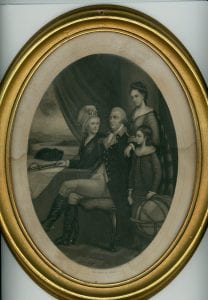
Mount’s choice of an openbacked bust approximating a mask allows the viewer to see the reflections of the vase beyond it, the whole of which, vaguely reminiscent of anthropomorphic composte portraits by artists of 16th Century Italy, hints not only of the shared reflections of Greene and Washington, but also Mount’s mother.
Greene bore the same Christian name as Mount’s ancestor Zachariah Hawkins, an early settler of Setauket, thereby offering the artist a parallel perspective of the great-grandchildren around Greene in the personas of ‘Mount’s mother’ relating her memory of Washington to ‘her son’ writing down and sketching her story.
The mask-like bust of Washington serves as an allegorical reminder of the ‘masks’ that were the cover stories, donned by spies in the field to conceal their intelligence-work. Though likely unknown to Mount, but in keeping with his allusion to the Mount family story, spycraft called ‘masks’ employed by British General Sir Henry Clinton against the Culpers, used a cut paper silhouette to delineate specific words on a piece of correspondence to create a message within an otherwise harmless ‘cover story.’
Ironically, in 1856, Mount was asked to paint a mural for the Senate chamber’s eastern staircase in the nation’s Capitol building, picturing the death of Clinton’s spymaster Major John André. Dressed as a civilian behind American lines, André was searched and the documents found wedged in his boot, together with intelligence from the Culper Spy Ring, revealed Benedict Arnold’s plans to betray West Point in 1780. Andre’s capture and fate by hanging as a spy was the daily risk of members of the Culper Spy Ring under British occupation
Two artists’ legacy today
Milne, who provided the earliest known views of Smithtown, rests today with his family in the churchyard of the Hauppauge United Methodist Church (1806), the oldest church building in the township of Smithtown.
The church and cemetery were recently placed on the National Register of Historic Places (2020); and Milne’s work, once collected by Nelson and Happy Rockefeller, is preserved in private collections. His work is also at the Michele and Donald D’Amour Museum of Fine Arts, Springfield, Massachusetts in The Horace P. Wright Collection; The Long Island Museum, Stony Brook; and the Smithtown Historical Society.

Looking west in his painting, not one of the buildings Milne depicts in Smithtown that Washington would have seen, still stands in situ. Washington’s carriage would have travelled around the corner where the Presbyterian church (built in 1827 after the tour) stands today, to head west to Huntington and New York City where the first capital of the new nation was then located.
Farther west on Main Street, the Arthur House (1752), eligible for the National Register of Historic Places, is the only 18th century building in Smithtown, located where it stood when Washington passed it in 1790. It was the home of Mary Woodhull Arthur (1794-1853), daughter of Abraham Woodhull, code name Samuel Culper, Senior, Washington’s chief spy.
Owned by the Smithtown Central School District, it has been vacant for years, diagonally across from Town Hall. My calls for restoration and a recent request that its name be officially changed to the ‘Mary Woodhull Arthur House,’ to recognize Culper, Senior’s daughter, a true Daughter of the American Revolution, have received no response.
The Blydenburgh Tavern (c. 1688) was demolished in 1907; and to the near left of it in Milne’s view, the two-story Epenetus Smith Tavern was moved twice, the first time thanks to the preservation efforts of Mary Miller, mother of Captain James Ely Miller (1883-1918), the first American aviator killed in combat over France in World War I. In 2017, Captain Miller posthumously received the first Distinguished Flying Cross presented to a WWI recipient. The Miller Home (built before 1873), once located across from the Smith Tavern, was demolished in the 1960s.
In 2017, the North Shore Promotion Alliance and The Ward Melville Heritage Organization were instrumental in getting Spy Trail signs installed, commemorating the importance of the Culper Ring along the route of Washington’s tour. A focal point on that trail, the William Sidney Mount House is a National Historic Landmark. The scene is set for Mount’s painting that never was.
Mount’s idea for a work commemorating Washington’s 1790 tour and the courage of Julia Hawkins would be an excellent reason for North Shore artists to open their sketchbooks and step up to their easels in a salute to the traditional autumnal ‘Spy Days’ sponsored by the Three Village Historical Society, Tri-Spy Tours, The Long Island Museum and The Ward Melville Heritage Organization.
About the author: Independent Historian Corey Geske of Smithtown was researching a book on Alexander George Milne when area historic preservation became a priority following demolition (2016) of the Jonas Hawkins, Jr. home (before 1858) called Sedgemere at Head of the Harbor, Town of Smithtown. In 2016, she proposed recognition of the New York Avenue School as an historic structure and restoration of the Arthur House in situ, proposing their inclusion in a National Register Historic District in downtown Smithtown. She prepared the report resulting in the determination of the Smithtown Bull as Eligible for the National Register (2018); wrote the nomination for the Byzantine Catholic Church (1929) by McGill and Hamlin, and its Rectory, the former Fred Wagner Residence (1912) by Gustav Stickley, that were placed on the National Register (2019); and worked with church Trustees to nominate the Hauppauge United Methodist Church and Cemetery to the National Register (2020).

